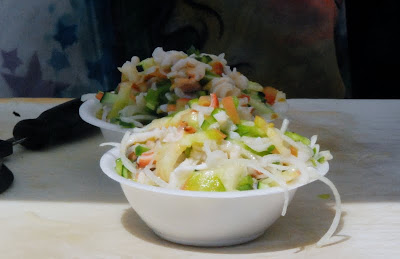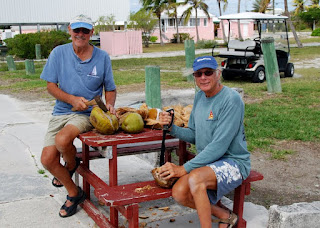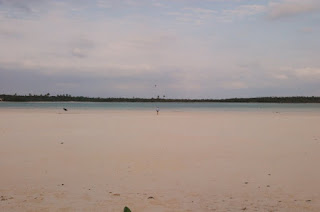Underway Again #20: Spanish Wells
On Monday, the winds died down a little and Bill picked us
up in his dinghy and took us over to Kalunamoo for supper. We looked at the charts and decided to try
for Spanish Wells the next day. We
would leave before dawn and try to make Current Cut at slack tide. Current Cut is a difficult cut as the water
pours out of the cut at 4-6 knots and with the tide running against a strong
breeze, a nasty chop is raised at the entrance. If you enter is with the tide, your boat would be tossed to and
fro and it would be difficult to maintain stability.
We left at 4:15 in the morning and it was mostly motor sailing on quite calm waters with little wind. Now we would have liked a little wind! We made good time and went safely through the cut about 2:00 staying to the side as the guide books indicated and then into Spanish Wells Harbour again reading the guide books about what side to hug.
 |
| First view of harbour in Spanish Wells |
There are numerous sand banks in the harbour and at high tide,
when we were entering, the sand banks are not visible and we guessed that the pole sticking out near the shore and the mooring ball were the markers for the entrance.
 |
| Spanish Wells Yacht Haven Marina |
We had contacted
Spanish Wells Yacht Haven Marina and reserved a spot and we were placed on a
long dock behind a 42 ft. sailboat.
 |
| Can you spot our boat? |

The first thing that I did was take a long hot shower - what a
luxury!
The first thing Roman did was
to walk to the marine stores to look for glue for the dinghy but he did not
have any luck so he will just have to use the rest of the glue he bought in
Georgetown. This pictures illustrates just how much of the dinghy has come apart. Hopefully this last attempt will last us until we get back to the mainland.
The name Spanish Wells is said to have originated three
centuries ago when the Spanish explorers declared the local well water the
sweetest in The Bahamas. It is a very
insular community quite unique to the Bahamas in that in more than 300 years
the makeup of its population has hardly changed. Most residents used to grow up, marry and remain here. Spanish Wells has a long association with
the sea. It is a remarkably
self-sufficient; even the power system is locally owned.

As a premier Bahamian fishing port more than
seventy percent of the annual harvest of lobsters is caught by the Spanish
Wells fishing boats.
The boats now have
to travel further and further to find lobster.
There is difficulty in keeping young men in school as they can go out on
the lobster boats at age 16 and earn $100,00.00 and more yearly.
That is a great incentive to leave school early.
The next day we walked around and explored.
Prosperity is reflected in the neat and tidy
houses surrounded by colourful gardens, carefully tended and many with
beautiful hibiscus plants, roses, cacti, and prolific trees.
Everything is orderly; most shops close on
Wednesday afternoons and all day Sunday and there is no liquor store on the
island.
However one man came and handed
us a card that he has a liquor store and even has a license for it.
We plan just to check it out for curiosity's
sake.
Spanish Wells is located on St.
Georges Cay and along the north side is a beautiful beach.
We walked along the beach noting that most
of the homes along the beach are private homes with a cement wall along the
edge of their property where it meets the beach.
Some workers were painting one of the walls and they told us that
the water comes up to the wall at high tide and during a storm the water goes
right over these walls often right into the homes.
 |
| Every evening at sunset the boaters blow their conchs. |
That night the boaters organized a pot luck on the
dock.
This was a great opportunity to
meet the rest of the boaters.
Most are
waiting for a weather window to go north to the Abacos although some are
travelling south.
These are the boats
that plan to get down to Trinidad or Grenada for the hurricane season.
It was a great evening and the wind was
strong enough that there were no "noseums" which just love to feast
on humans.
There are many Canadians
here in the Bahamas and often the Americans joke that Canada is taking over.
 |
| Waiting for the fast ferry seen coming up behind us. |
 |
| Look closely to the right and you can see the waves breaking on the reef. |
The next day we took a fast ferry through
the Devil's Backbone around the north coast
of Eleuthra to Dunmore Town on Harbour Island.
The Devil's Backbone is a passage through the reefs reef so named as it
is potentially very where there is only one way to go or else you will land up
on the reefs as have many ships.
If you
wanted to go through with a sailboat, a guide is the only way to go and you
cannot attempt the passage with wind, waves, or swells coming ashore from the
N, NE or NW.
You can't go with the sun
in your yes in the morning as you must rely on visual navigation and on top of
that, high tide is an extra bonus with two extra feet under your keel.
Thus the decision was made to take the fast
ferry and just spend the day on Harbour Island.
 |
| First view of Dunmore Town, Harbour Island |
Harbour Island, known as "Briland" to the locals,
is one of the oldest established settlements in the Bahamas and was the first
capital city of the Bahamas dating back to the 1700's.
 |
| You see a multitude of golf carts as they are the main form of transportation |
Dunmore Town boasts of old churches, art galleries, quaint
shops, stone walls and a unique blend of colonial architecture combined with
striking Caribbean colours.
We walked
up and down the hilly streets to the wide 3 mile tinted pink beach which draws
a multitude of tourists.
 |
| Overlooking the beach |
 |
| Steps down to the beach from the seat above |
Most of the
island's tourist accommodations sit on a bluff
overlooking the rosy beach. Many
restaurants and bars offer a fantastic view.
We walked along the beach and although its is advertised as a
"pink" beach we did not think it was very pink although it was very
beautiful. Surprisingly, as you can see from the picture above, there were few
people on the beach, perhaps because the wind was from the north.
There are a multitude of restaurants most of
which are very pricey. We had
grilled grouper for lunch and on the way to the ferry, I bought a wonderful
tasty conch salad made by Martin who lives in Eleuthra and takes a small ferry
to Dunmore every day to a stand on the beach right near the government dock
where the fast ferry docks. He brings
with him sweet sour oranges, cucumbers, tomatoes and green peppers all grown in Eleuthra. Roman got a conch burger at a local stand
and we ate on the ferry on the way back.
It was delicious!
 |
| Making a conch salad is harder than it looks. First you choose your conch. |
 |
| Next Martin has to take the conch out of the shell. |
 |
| Then he has to cut only the part he will use. |
 |
| Now he will chop up all the ingredients, add the orange and lime juice and, of course, the conch. |
 |
| The finished product! |
Some of the little shops - quite unique displays!

































